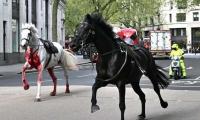Least noticed by the mainstream Pakistani media was the demise of the Bishop Ijaz Inayat Masih of Karachi. He was the soft power of Pakistan touring around the globe lecturing on various topics such as Christianity, tolerance and coexistence among the faithful. However, he was widely acclaimed as the unsung hero for another reason. The preservation of a 19th century historic Church building in the heart of Karachi city—the Saint Patrick's Cathedral—was owing to his dedication and efforts.
The beauty and charisma of the building are a testimony to the finest of the architects of the English Raj period of our history. Despite the last two decades of mayhem and chaos in Karachi, the church and its auxiliary property did not fall to vultures of china-cutting and land grabbing mafias. The prime location of this rare piece of property near the famous Zainab Market is worth billions of rupees. Thanks to Bishop Ijaz Inayat the property was saved and the colonial legacy was passed on to another generation of Karachiites to preserve and cherish.
"My father (Bishop Ijaz Inayat) believed in Pakistan's diversity, its history and its identity. For him, Karachi was mini-Pakistan in an architectural sense, a cradle of civilisations," said his younger son Zeeshan Ijaz, a solicitor by profession.
The second historic building is the Frere Hall—a wonder and masterpiece of British heritage. Its awe and grandeur have simply no match. The breathtaking yellow colour and the use of wood and bricks are a statement of the skill and expertise of the bygone-era artisans. To have this historical monument in the posh locality of Karachi is a blessing for tourists and history-lovers to visit while in Karachi.
Unfortunately, the building is now in poor condition and neglected by the relevant authorities. Though a listed building of Unesco, it has not been updated. The Archeological Department of Sindh and the federal government are bound to restore this historical treasure to its original glory. Aside from the government's responsibility, philanthropic contributions should be tapped in by leading figures of Sindh to preserve our living history from disappearing into oblivion.
Another temple, a historic building of the Old Town of Karachi, has fallen victim to the builder mafia. The temple was a historic structure that has been demolished now. The Old Town is losing historical heritage fast: before the temple, the drinking water fountain disappeared. The deterioration and decay in the Old Town need to be arrested by the authorities concerned.
Nevertheless, among many buildings of Karachi, the jewel in the crown is the Georgian Customs House Mansion—the Georgian Architectural style is reminiscent of most buildings of the English-speaking world in vogue between 1974 and 1830.
Used to be an eyesore, the once derelict building and the associated historic temple was on the verge of extinction, while closeness to the Karachi Port and pollution of the heavy traffic dampened the yellowish colour of the dwelling.
However, an art-lover came along and took upon the task to restore the exterior to its original form. The front path was paved and the ponds of mud made way for artistic work of a new mosaic of bricks. The adjoining temple repaired, a special deity was imported from India and placed in the temple. Now proper rituals are performed by the Hindu community on an occurring basis.
The man behind the restoration of the building and temple was a gentleman named Dr Tariq Huda—a civil servant by profession, who had a unique passion for our rich history. He galvanised friends around the good case and raised private finances to work on the building. And in almost a year, the Customs House Mansion was back in its original form. Individuals like Tariq Huda are inspiration for many not awaiting government’s largesses to work for the good of the country.
Karachi's great contribution to Pakistani society in literature, poetry, sports, economy, health and charity is the outcome of the efforts and sacrifices of unsung heroes like Bishop Ijaz Inayat and Tariq Huda who have joined the legendary league of the great and the mighty of Karachi. A few of them are Dr Ruth Pfau (Pakistan's Mother Teresa), Javed Miandad, Shahid Afridi, Ardeshir Cowasjee Idress, Hakeem Saeed, Abdul Sattar Edhi, Mir Khalil-ur-Rahman, Ali Raza Abdi, Sabeen Mahmud, Moeen Akhtar, Jamshed Ansari, Mahendra Pal Singh, Rafia Baig, Parveen Saeed among others.
The list of the buildings is not confined to the above sites. The lesson we must learn is we need to activate archaeology departments in both big cities and towns. Private philanthropists should be encouraged to contribute funds for the restoration, preservation and protection of architectural legacy.
The preservation of so many architectural sites is not only the government's job. The whole society needs to be prodded to play its role. Pakistan is the abode of former kings and ancient nobles and a cradle of old civilisation characterised by ancient places, monuments and relics. Let us vow as a nation to preserve our great history reflected in the great architectural monuments of Karachi and other parts of Pakistan.
Jan Achakzai is a geopolitical analyst, a politician from Balochistan and an ex-adviser to the Balochistan Government on media and strategic communication.He remained associated with BBC World Service. He is also Chairman of the Institute of New Horizons (INH) & Balochistan. He tweets @Jan_Achakzai
PTI leader Azam Khan Swati. — The News/File ISLAMABAD: A local court on Tuesday confirmed the bail of PTI’s...
An exterior shot of the FIA headquarters. — Facebook/FileISLAMABAD: The Federal Investigation Agency , breaking a...
Sarhad Chamber of Commerce and Industry president Fuad Ishaq. — Facebook/Fuad Ishaq PESHAWAR: Sarhad Chamber of...
Sarfraz Bugti. — APP/FileQUETTA: Balochistan Chief Minister Sarfaraz Bugti has said that a committee is being formed...
Chairman Joint Chiefs of Staff Committee General Sahir Shamshad Mirza conferred civil awards to the eminent...
Former federal minister Fawad Chaudhary. — APP/FileMULTAN: Former Pakistan Tehreek-e-Insaf leader Fawad Chaudhry has...







